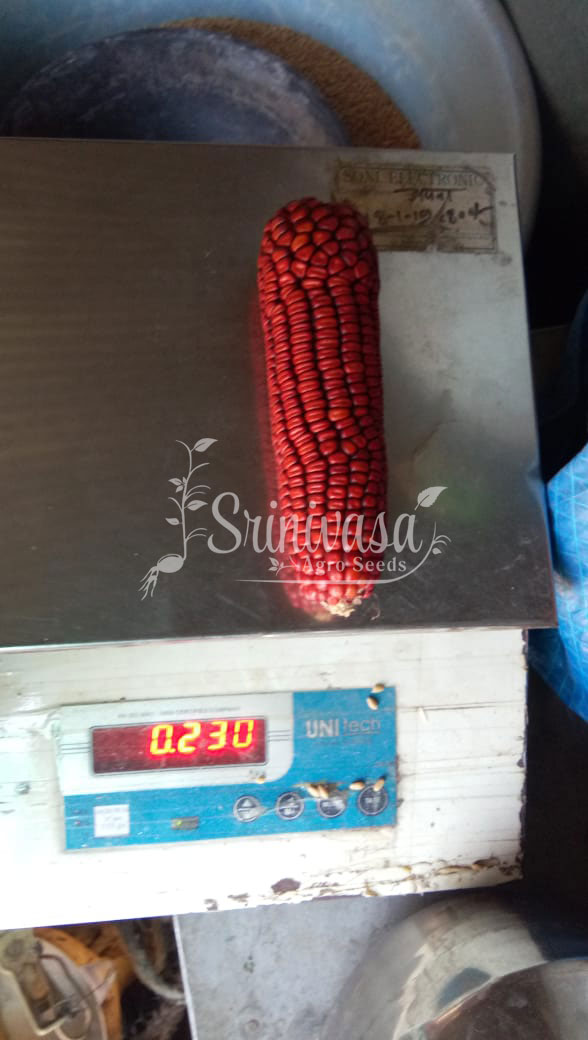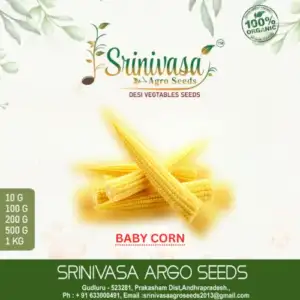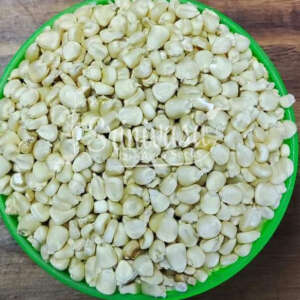Description
SEED TYPE : Non-Hybrid, Open Pollinated And Non-GMO
PLANT TYPE : Tall & Steady
Corn Type : Large Red kernals
Seed Rate : 10 kg per Acre
SOWING TIME: Throughout the year Mainly summer
SOWING METHOD : Directly from seed
GERMINATION TIME : 6 – 8 Days
GROWING CONTAINER : 12 inch height pot / Raised bed.
GROWING MEDIA : 2 part Garden soil 1 part Cocopeat 1 part Vermicompost
HARVESTING : 90 Days after sowing (4 – 5 Corn)
DESCRIPTION :
The first type of corn, sometimes known as Indian corn or maize, was found by the Pilgrims when they arrived on the shores of the New World. Provided by the Indians, this valuable resource ensured their survival. In addition to eating the corn, the resourceful Pilgrims also used the husks for making various things like shoes, ropes, dolls, and seats for their chairs. Modern varieties of sweet corn, field corn, and ornamental corn all descend from Indian corn seed.
Sowing: Prepare the soil with compost or other organic matter. One week after frost or when the soil consistently reaches 60 degrees F, plant the Indian corn seeds 1″ deep and 8-12″ apart. Planting blocks of four short rows ensures good pollination. Germination should take place in 5-6 days. For companion planting benefits, plant corn with cucumbers, peas, or pole beans; plants that like shade also do well with corn. Avoid planting tomatoes near corn.
Growing: After the corn emerges, keep it moist and carefully remove weeds; since corn cannot fight against weeds, mulch may be beneficial. Additional organic matter or compost helps growth, since corn is a heavy feeder. Keep in mind that corn has shallow roots which can easily become damaged by hoeing. Watch out for pests, as corn attracts many problematic insects and animals.
Harvesting: Leaving the corn on its stalks to completely dry in the field gives the best results; when they are ready to harvest, the stalk and the ears will be completely brown with no green coloring at all. However, since continued rainy weather and humidity compromise the quality of the ears, it may be necessary to continue drying them inside. Choose a dry location with moderate heat, but out of direct sunlight; hang the stalks upside down, or lay them out flat. Ruby Red corn makes an excellent corn either for ornamental purposes or for popcorn.
Description/Taste
Red corn varies in size, shape, and appearance, depending on the variety, and most commercial cultivars are generally harvested when they are around 19 to 30 centimeters in length. The ears of corn grow from upright, tall leafy stalks and are encased in layers of tightly packed pale green leaves known as the husk. Inside the husk, there are also thin strands of brown, green, to yellow fibers called silks that arise from the top of the ear. When the silk and husk are stripped away, Red corn cobs are covered in dense, compact kernels. The kernels range in color from pale red, pink-red, crimson, brick red, to red-purple and often have a taut, glossy, to matte appearance. It is worth noting there are several types of Red corn with varying characteristics, and the kernels may exhibit indentations or be curved and plump, depending on the variety. Red corn cobs are typically thinner than yellow or white varieties, and the kernels have a semi-firm, crisp, and chewy nature with a succulent, crunchy, and snappy consistency. Only Red sweet corn varieties are consumed fresh and are harvested young to have a refreshing, sweet, nutty, and earthy flavor due to their high sugar content. If left in storage, the sugar will convert to starches, developing a chalky and bland flavor. Red sweet corn can also be cooked, creating a soft, semi-firm texture. The flavor will mellow and become mild, earthy, and sweet.
Seasons/Availability
Red corn is generally available from the early summer into fall. Seasonality will vary depending on the hemisphere and climate it is grown in and the type of Red corn.
Current Facts
Red corn, botanically a part of the Zea genus, is a broad, general category used to describe several types of pigmented corn belonging to the Poaceae family. Red corn is also known as Red Maize and is native to the Americas, where various species have been selectively bred and cultivated over time to create unusual varieties with pale red, crimson, to variegated red hues. Red corn is less common than white or yellow corn varieties, but the colored cobs are increasing in popularity worldwide as specialty growers are becoming familiar with Red corn’s nutritional benefits, textural quality, and flavorings. There are three main types of Red corn with varying uses: field corn, sweet corn, and flint corn. Field corn, also known as dent corn, is classified as Zea mays var. indentata and is varieties with high starch and low sugar. These cultivars are primarily dried and processed into liquors, flours, and cornmeal. Common Red field corn varieties include Bloody Butcher, Tennessee Red Cob, and Jimmy Red corn. Sweet corn, Zea mays, is the only type of Red corn that can be eaten fresh. These varieties have a high sugar content and are picked young for culinary purposes. Popular varieties of Red sweet corn include Ruby Queen and Double Red. The final type, flint corn or Indian corn, classified as Zea mays var. indurata, bears hard and dense kernels used for popcorn, flour, grits, polenta, and other processed items. Most of South America’s heirloom Red corn varieties fall under this category, and notable cultivars include Ruby Red corn, Strawberry popcorn, New York Red Flint corn, Red Aztec, and Floriani Red Flint corn. In the modern day, Red corn is a specialty grouping of pigmented varieties grown worldwide for culinary uses and other commercial purposes. Depending on the market, the varieties are sometimes challenging to find and are produced through small-scale growers, home gardeners, and select seed savers.
Nutritional Value
Red corn is a source of fiber to regulate the digestive tract, vitamin A to maintain healthy organ functioning, and calcium to build strong bones and teeth. The kernels also provide vitamin C to strengthen the immune system while reducing inflammation, iron to develop the protein hemoglobin for oxygen transport through the bloodstream, potassium to balance fluid levels within the body, and other nutrients, including manganese, zinc, copper, phosphorus, and magnesium. Vitamin and mineral content will vary depending on the specific Red corn variety. The colored kernels also contain anthocyanins, pigmented compounds naturally found in the kernels that have antioxidant properties to protect the cells against free radical damage and inflammation.
Applications
Red corn has a subtly sweet, earthy, and slightly starchy taste suited for fresh and cooked preparations. It is important to note that there are several types of Red corn, and only sweet corn varieties are considered edible when raw. Field and flint corn are processed into cornmeal, starches, and flour. Red sweet corn can be used interchangeably with yellow and white sweet corn in various culinary recipes and is popularly mixed into dips, tossed into salads, or combined with fresh herbs and aromatics as a side dish. Red sweet corn is also added to soups, especially tomato-based, chowders, chilis, and stews, or it is layered into quesadillas. Try sautéing the fresh kernels in spices and sprinkling them with cheese as a flavorful side dish or simmering them into grits. Red sweet corn is also made into polenta, roasted or grilled for a smoky flavor, or steamed to soften the kernels. It is not recommended to boil the variety as it will lose its red coloring. Depending on the cultivar, some flint and field varieties of Red corn are ground and processed into pancakes, tortillas, hominy, grits, or cornbread. Other varieties are suitable for popcorn, producing fluffy, crisp, expanded kernels. Red corn pairs well with tomatoes, shelling beans, squashes, citrus, herbs such as basil, cilantro, and parsley, seafood including clams, shrimp, fish, and scallops, pork, nutty cheeses, chiles, and spices such as cumin, paprika, and garlic. Fresh Red sweet corn should be immediately consumed for the best quality and flavor and will only keep for 1 to 3 days when stored in the refrigerator with its husks still intact. Dried Red corn can last for years when stored in ideal conditions, such as a sealed container in a cool and dry place.









Reviews
There are no reviews yet.